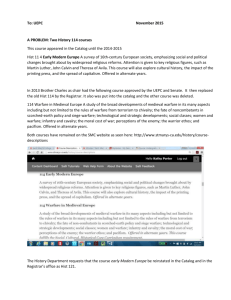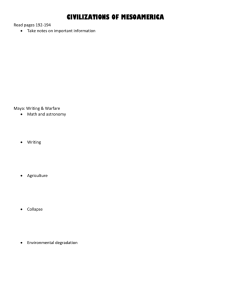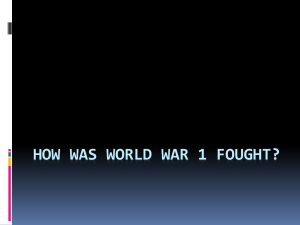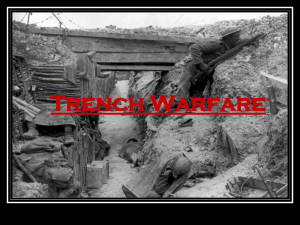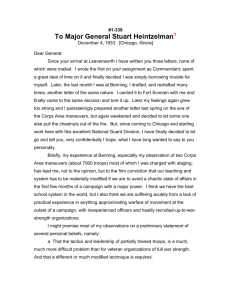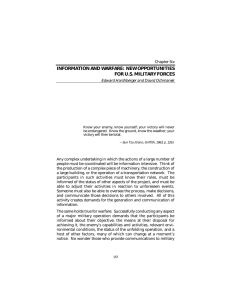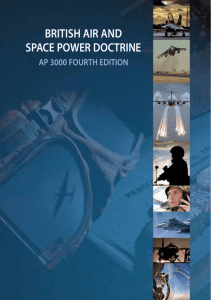1-270 - George C. Marshall Foundation
advertisement
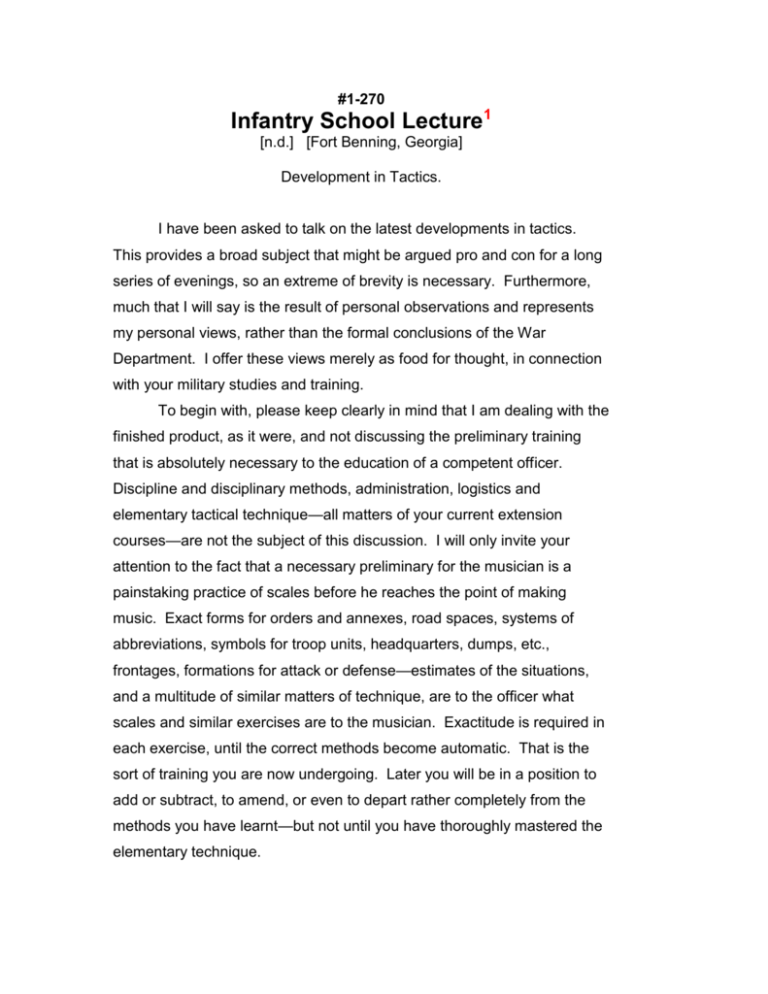
#1-270 Infantry School Lecture1 [n.d.] [Fort Benning, Georgia] Development in Tactics. I have been asked to talk on the latest developments in tactics. This provides a broad subject that might be argued pro and con for a long series of evenings, so an extreme of brevity is necessary. Furthermore, much that I will say is the result of personal observations and represents my personal views, rather than the formal conclusions of the War Department. I offer these views merely as food for thought, in connection with your military studies and training. To begin with, please keep clearly in mind that I am dealing with the finished product, as it were, and not discussing the preliminary training that is absolutely necessary to the education of a competent officer. Discipline and disciplinary methods, administration, logistics and elementary tactical technique—all matters of your current extension courses—are not the subject of this discussion. I will only invite your attention to the fact that a necessary preliminary for the musician is a painstaking practice of scales before he reaches the point of making music. Exact forms for orders and annexes, road spaces, systems of abbreviations, symbols for troop units, headquarters, dumps, etc., frontages, formations for attack or defense—estimates of the situations, and a multitude of similar matters of technique, are to the officer what scales and similar exercises are to the musician. Exactitude is required in each exercise, until the correct methods become automatic. That is the sort of training you are now undergoing. Later you will be in a position to add or subtract, to amend, or even to depart rather completely from the methods you have learnt—but not until you have thoroughly mastered the elementary technique. Before commenting on recent tactical developments, I will ask you first to think back to the World War in its fourth year when the American Army appeared on the battlefield. That was a very special form of fighting, one of static or semi-siege warfare. It seemed very complicated because of the elaborate system of fighting sectors into which the front in France had gradually developed—immense masses of artillery, a maze of trenches, barbed-wire and concrete emplacements, thousands of miles of 60-centimeter railroad actually operating on the battlefield, huge dumps of ammunition and supplies, and installations comparable to the public utilities of great cities. Vast and complicated as this set-up appeared to us, it was more or less fixed in place. Our maps showed every enemy trench. We had photographs of his principal emplacements. We usually knew his strength, the location of most of his cannon and machine guns, the numeral and history of his organizations confronting us. Green troops in a sector therefore had some chance of saving themselves from the full penalty of their errors. Similar failures in warfare of movement would have led to the destruction or temporary disintegration of a command. In contrast, picture the opening campaign of a war. It is a cloud of uncertainties, haste, rapid movements, congestion on the roads, strange terrain, lack of ammunition and supplies at the right place at the right moment, failures of communications, terrific tests of endurance, and misunderstandings in direct proportion to the inexperience of the officers and the aggressive action of the enemy. Add to this a minimum of preliminary information of the enemy and of his dispositions, poor maps, and a speed of movement or in alteration of the situation, resulting from fast flying planes, fast moving tanks, armored cars, and motor transportation in general. There you have warfare of movement such as swept over Belgium or Northern France in 1914, but at far greater speed. That, gentlemen, is what you are supposed to be preparing for. Our officers are almost entirely without practical experience in warfare of movement. Their fighting was confined to the final phases of static warfare. Naturally, it is extremely difficult to break away from the conclusions formed in this special type of fighting. Yet the great military problem of the United States is the rapid mobilization and concentration of field armies and their early employment in warfare of movement. With this in mind, it was observed by many officers in our troop maneuvers at the service schools, that methods of technique practicable in France, were often ineffective in open warfare. Certain things became glaringly evident. Warfare of movement was a far more difficult matter than static warfare; mistakes were much more easily made and were far more devastating in their result; large scale maps were seldom available and the solution of tactical problems on an ordinary geological survey map or with no map at all required much more skill than when a map of the Gettysburg type was available;2 long orders were usually impossible of preparation and written orders were infrequently issued; the brief oral or written order required much more of skill than the detailed affair common to the World War; time was always short, delays were usually fatal; directions and boundaries were difficult of arrangement—the latter often impossible of designation; the tactical methods necessary for the controlled employment of partially trained officers and troops were different from those required for veteran personnel. Even the best of regular officers found the problems of warfare of movement extremely difficult to handle. Above all, it was apparent that few had a correct idea of the various applications of the fundamental principle of simplicity. So far I have generalized. A few specific examples may be helpful. Take, for instance, the preparation of orders. In France in 1918, days, often a month elapsed between the decision to attack a certain front and the actual operation. Detailed orders were prepared long in advance, special maps were lithographed, ammunition and supplies were accumulated, and at times the troops actually rehearsed a specific operation. Naturally, every item of preparation that could be foreseen was carried out in minute detail. Time was not the dominating element. Information of the enemy was complete to a remarkable degree. The real problems were secrecy of preparation and the judicious allotment of dense masses of preliminary and covering fires. Yet even in France, within the fixed sectors assigned to divisions and brigades, the moment the first phase, the first morning’s fighting, was completed the real troubles began—no orders or orders received too late, misunderstandings, lack of information regarding the enemy’s new dispositions, the human factor exaggerated to the Nth degree. Our troops usually made the initial advance in good form. Later, in the hurly burly or rapidly changing situations, their lack of training demanded an appalling toll of life or limb. We have come to view the quality of our participation through roseate glasses, the stumbling, blunderings, failures, appeals for help, and hopeless confusion of the moment have been forgotten in the single thought of final victory. Compare this with August 1914. The order for the entire British Expeditionary Force was, on at least one occasion, a single sentence ordering a further retreat! The dominant consideration was the problem of getting that single sentence to all the troops in time. Consider the question of maps on that occasion. A mass of detailed maps of Belgium and Northern France had been provided but their bulk was so large, the movements into new terrain so rapid, and the difficulty of distribution so great, that none were actually made available and motor maps obtained locally were employed. Yet you probably have come to expect a large scale Gettysburg map as a matter of course. Unfortunately, such a map is necessary for the purposes of theoretical instruction in troop leading and the staff work for small units. And the officers concerned in this type of instruction are the very ones who would most frequently have to work without maps or with only the small scale variety. Another example: Communications in France were matters of elaborate arrangement—ground wireless, air wireless, the buzzer, telephone, runners, and pigeons, the headquarters usually located in dugouts offering rather complete shelter. Picture an Infantry regiment in warfare of movement, entering under cover of darkness, terrain never before seen, and under the necessity of attacking at dawn—machine guns here, howitzers there, first line companies, supports and reserves, communication with the distant artillery to be assured, command posts scattered about in the open, runners fumbling about in the dark, breakfast to be distributed, orders to be delivered. Do you think all this an easy matter as compared to the more deliberate arrangements possible in 1918? Can you imagine long written orders? Do you suppose tired, irritated and nervous officers will misunderstand this or that, or fail to comprehend their full part in the hurried preparations? Four things are necessary to success under these considerations—discipline that triumphs over fatigue and danger, a thorough grasp of the technique involved, and a knowledge of two vitally important matters—real simplicity and correct methods for maintaining control. Consider another aspect of the problem in warfare of movement. We are all taught how to set up a command post and establish communications. But that has been found not to be the real difficulty. The troublesome question is, when to make a complete set-up, when to lay all our wires. A premature set-up kills the momentum of the movement and expends valuable wire. Yet how do we maintain control without the complete set-up; to what degree do we first establish a command post? Consider the matter of direction and boundaries. Without a detailed map, a graphic solution is not often possible. How then, will you manage this? Can you think of a substitute for coordinates, named ridges, hills, and rivers, that all can see on the detailed maps? Let us consider the opening phases of a fight, advance guard or leading detachments driving in the enemy’s covering detachments in order to develop the main line of resistance, and something of the hostile dispositions. Machine guns and automatic rifles are much more deadly weapons today than in 1918. We have improved tremendously in our technique for handling them. How quickly then do you think small covering forces could be driven in? How much fighting and time would be required to make certain you were merely opposed by a small group with a few automatic weapons? To what extent would these small actions cause premature deployments, loss of time and loss of direction? Go further into the fighting, and a very serious problem arises, for which we have not yet found a satisfactory solution. The machine gun opposing you is seldom in your front. It is usually one or two thousand yards off to your flank, completely concealed from view to its front, and well concealed from your view. How will you meet this dilemma? Even after you locate the gun, how will you be able to designate its position for effective artillery fire or trench mortar treatment? Naturally, the enemy will do all in his power to disguise the layout of his front, and to disarrange the direction of advance of your several units. How will you offset this difficulty? In all these matters there is one phase of the question that we find exceedingly difficult to treat in theoretical instruction and that is this—when to make decisions, rather than what decision to make. Your tactical problems of necessity are usually confined to a requirement calling for your decision and order. This is not the real difficulty, that is the question of when to make a decision. The situation changes constantly. Do you constantly change or alter your decision? Of course not, but when does the moment arrive when you should decide on a new course of action? Summing up these various difficulties, it is apparent that the tactics of future periods of warfare of movement, demand a knowledge of how to operate by means of brief, concise oral orders, based on the ground you can see or on maps with very little detail. They require a knowledge of how to maintain control and direction of units necessarily much dispersed. They compel action when very, very little is yet known of the enemy’s dispositions. They involve the necessity for very perfect teamwork between the Infantry on the one side and the artillery, aviators and various commanders on the other. They necessitate a high degree of cleverness in locating enemy machine guns and designating their positions for the effective fire of distant units. They compel a constant tactical readiness in security arrangements as well as in battle tactics, in preparation for the sudden appearance of tanks or other mechanized units in front, flank, or rear. In all these matters speed of thought, speed of action and direction and speed of operation is essential to success. Document Copy Text Source: George C. Marshall Papers, Pentagon Office Collection, Selected Materials, George C. Marshall Research Library, Lexington, Virginia. Document Format: Typed draft. 1. This manuscript, which Marshall may have developed from a presentation to a Company Officers’ Course, is the only Infantry School lecture preserved in his files. 2. The “Gettysburg map” was a multiple-sheet, detailed topographical map (scale 1:21120) of the area between Gettysburg, Pennsylvania, and Antietam, Maryland, which was commonly used to lay out school tactical problems. Recommended Citation: The Papers of George Catlett Marshall, ed. Larry I. Bland and Sharon Ritenour Stevens (Lexington, Va.: The George C. Marshall Foundation, 1981– ). Electronic version based on The Papers of George Catlett Marshall, vol. 1, “The Soldierly Spirit,” December 1880-June 1939 (Baltimore and London: The Johns Hopkins University Press, 1981), pp. 334–338.

